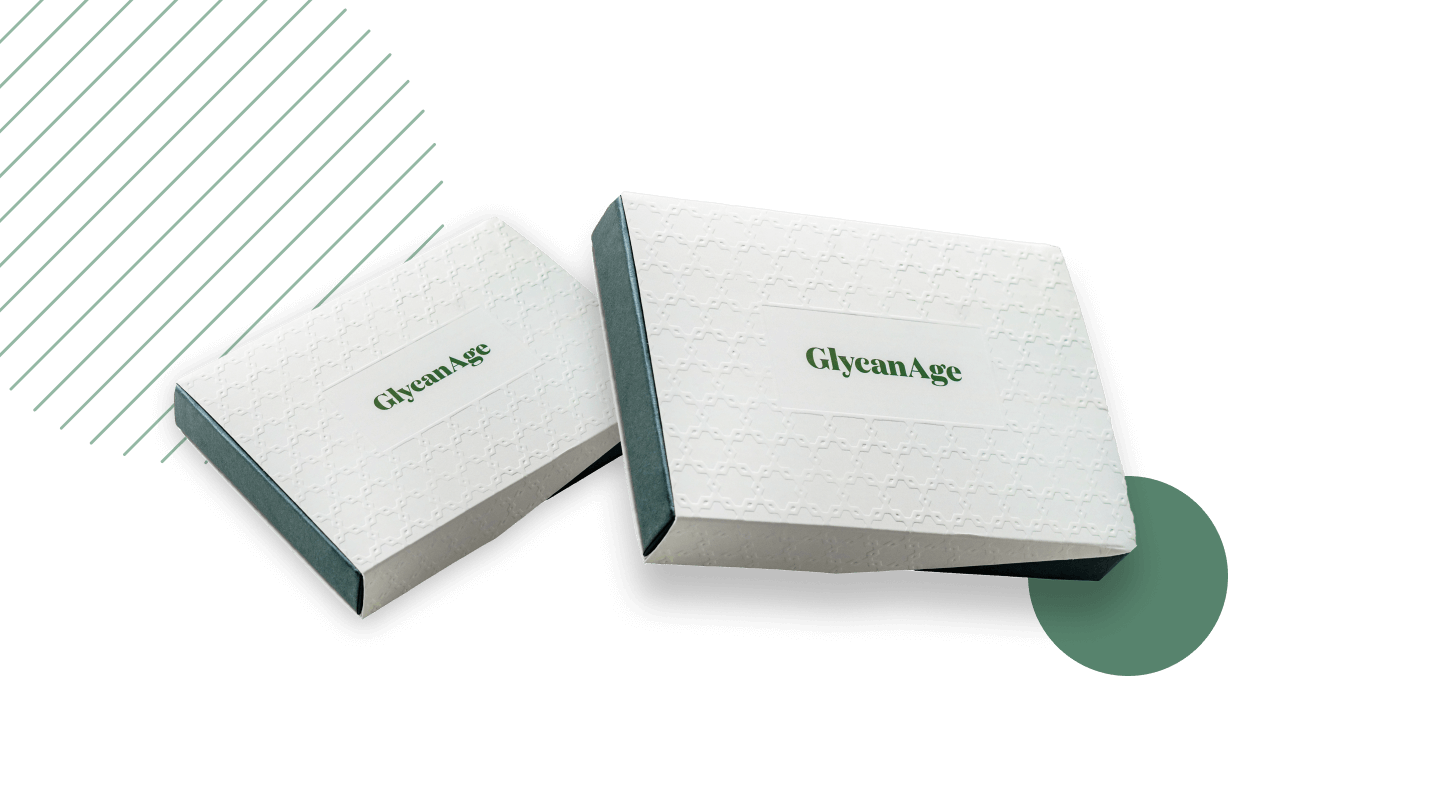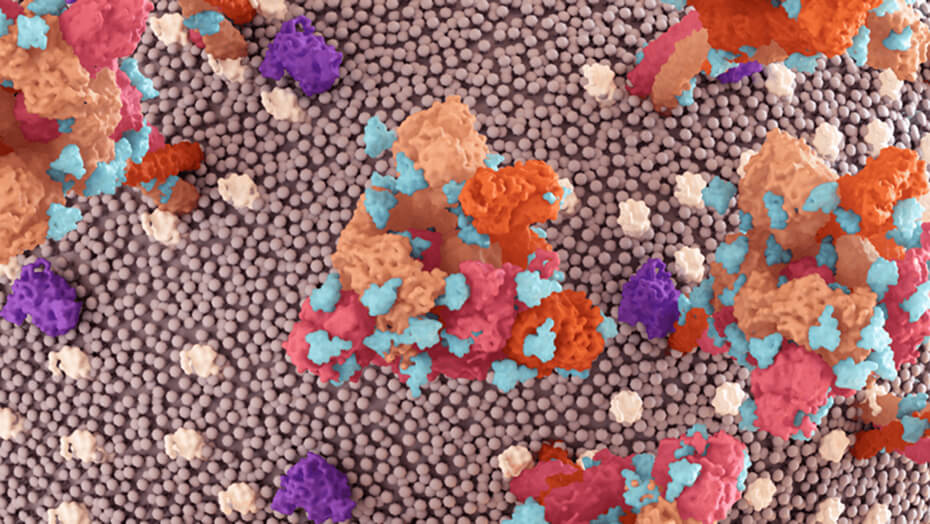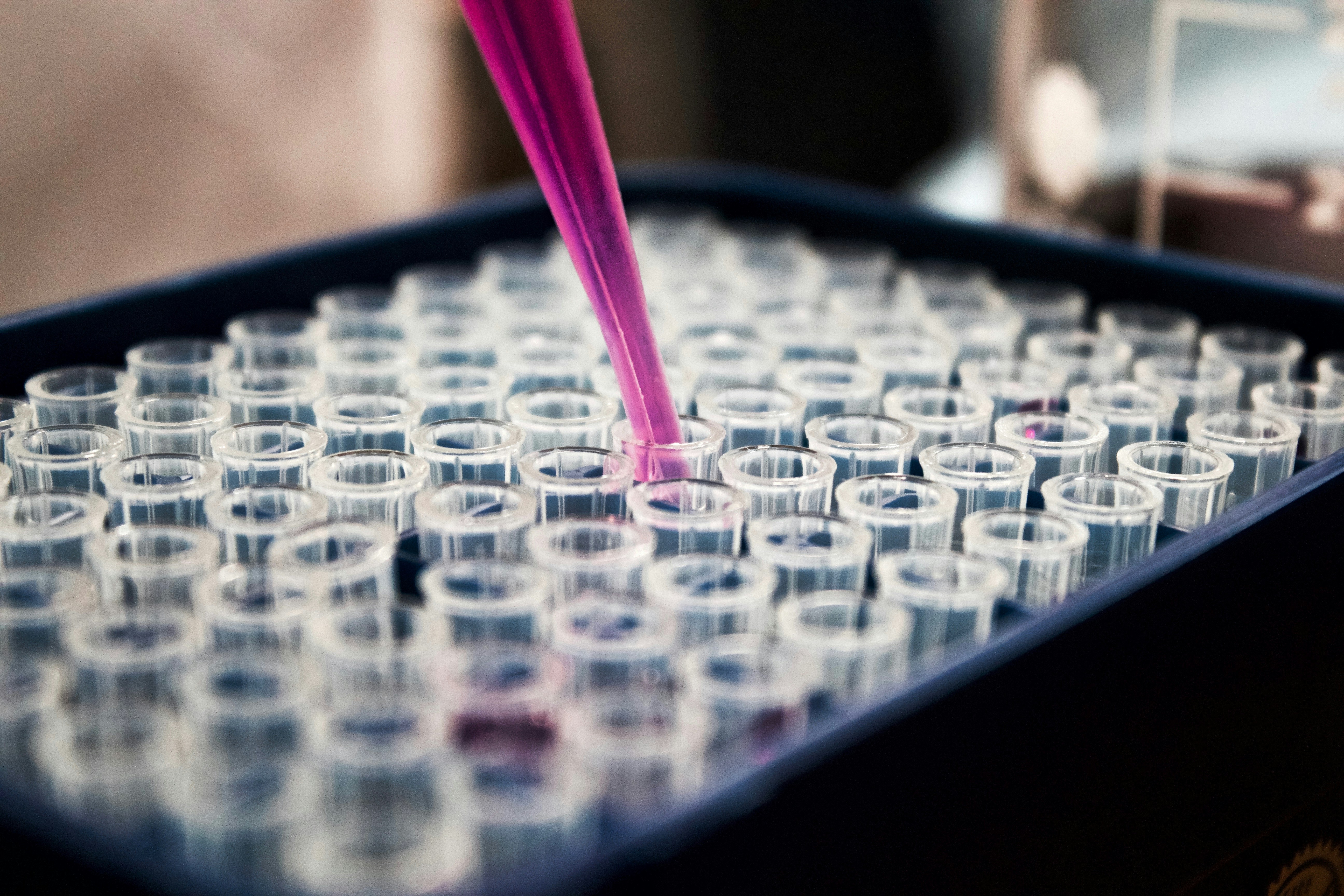Glycation: Impact on Health and Disease
Discover all about glycation: its definition, harmful effects, contrast with glycosylation, impact on skin ageing, diabetes, heart health, and tips to reduce it.

The core structure of proteins is built out of amino acids and it is encoded in our DNA. After the proteins are built, they can be further modified in various ways. Some of these modifications are strictly regulated and are crucial for the protein’s function, whereas others are spontaneous and can disrupt its activity. One of the latter modifications is glycation.
What is Glycation?
Glycation refers to the spontaneous addition of sugars to other molecules such as proteins, lipids, and nucleic acids. It is a form of biological damage associated with ageing, but also with various diseases.
Glycation of proteins is a posttranslational modification (PTM), meaning the sugars are added to proteins after they are built. Unlike the majority of PTMs, glycation is a spontaneous process and doesn’t require the activity of enzymes. Because of that, it is a fairly slow process, occurring over a period of weeks, most commonly affecting long-lived proteins.
Glycation can impact a wide range of proteins within the human body, including those found in the blood, brain, eyes, and skin. This attachment of sugars can induce rearrangements in the protein structure and impair its function. Additionally, glycated proteins may cross-link with other proteins or aggregate into 'clumps,' disrupting various biological processes and potentially leading to health complications.
The process of glycation involves a series of reactions, which are to a certain point reversible. The final products of protein glycation, after which the sugars cannot be removed, are called advanced glycation end products, or simply - AGEs. As their name suggests, they are implicated in the process of human ageing and have been linked with various diseases.
Understanding Advanced Glycation End Products (AGEs)
Advanced glycation end products (AGEs) are stable-end products formed through the glycation of proteins, lipids, and nucleic acids. They are ingested or produced de novo
The production of AGEs consists of a few steps, starting with Maillard’s reaction. Initially characterised in 1912, this process refers to the interaction between sugars and amino acids in heated conditions. Interestingly, this reaction is responsible for the browning and flavour development in a variety of foods during cooking or processing.
In the first step, a reducing sugar, such as glucose or fructose, covalently interacts with an amino acid in the protein, forming a Schiff’s base. This is an unstable product in which atoms can get rearranged to form more stable products called Amadori products. Up until this point, all the reactions are reversible. Amadori products can undergo further chemical reactions, ultimately leading to the formation of stable AGEs.
Along the way, additional compounds, collectively termed as reactive dicarbonyl intermediates, are created. They can be formed in every step of this process, either from glucose, Schiff base, or Amadori products. These compounds serve as additional precursors of AGE formation, further fueling their production.

AGEs can contribute to health problems in different ways:
Affecting protein structure and function
AGE formation can cause rearrangements in the protein structure, thereby impairing its activity and function.
Causing protein aggregation
AGEs cause different proteins to cross-link, ultimately leading to aggregation of proteins, which can disrupt biological processes.
Causing oxidative stress
During the production of AGEs, reactive oxygen species (ROS) are formed, causing oxidative stress to our tissues.
Activating cellular receptors
Activation of specific receptors for AGEs (RAGEs), results in the activation of various molecular pathways, including the induction of inflammation.
Why is Glycation Harmful?
As every important biological process in our body needs to be strictly regulated, the spontaneous addition of sugars to proteins and other molecules can have detrimental consequences for our health.
Glycation can exert harmful effects through several mechanisms, including:
Protein cross-linkage and their aggregation into “clumps”
Production of reactive oxygen species (ROS) leading to oxidative stress
Activation of RAGEs causes disruption of cellular signalling and increased inflammatory response.
Through these mechanisms, glycation can cause problems in various tissues:
- In the skin, it promotes skin ageing.
- In the bone, it increases the risk of fractures.
- In blood vessels, it promotes arterial wall stiffness and contributes to blood pressure increase.
- In the brain, it promotes plaque formation which may lead to the development of neurodegenerative disease.
- In the eye, glycation may impair vision and lead to cataract formation.
AGEs formed through glycation have been implicated in the ageing process and age-related diseases. With ageing, the accumulation of AGEs in various tissues and organs increases, which may contribute to the decline in tissue function and the development of various chronic diseases such as diabetes, cardiovascular diseases, neurodegenerative disorders, and chronic kidney disease.
Glycation and skin ageing
Glycation and the subsequent production of AGEs play an important role in skin ageing. The skin relies on key proteins like collagen and fibronectin for its youthful appearance and structural integrity, with collagen providing firmness and elasticity, and fibronectin being important for skin repair and regeneration.
Due to their long life, these proteins are good targets for glycation. By the time you reach 80 years of age, approximately half of your body’s collagen will be glycated. The process of glycation can impair the functionality of collagen and fibronectin, leading to accelerated skin ageing and the development of wrinkles, fine lines, and loss of elasticity.
Learn more about how to slow down skin ageing.
Glycation in Diabetes
Diabetes is a chronic metabolic disorder characterised by impaired glucose metabolism, either due to insufficient insulin production by the pancreas (type 1 diabetes) or the body's inability to effectively use insulin (type 2 diabetes).
Diabetes and glycation are closely intertwined, as diabetes is characterized by persistent hyperglycemia, or high blood sugar levels, which can lead to increased glycation and production of AGEs. The accumulation of AGEs has been proposed as one of the main drivers of diabetes-related complications. Glycation damages the blood vessels in various tissues and can therefore cause vision impairment (diabetic retinopathy), kidney malfunction (diabetic nephropathy) and nerve damage (diabetic neuropathy).
Glycated proteins can also be used as biomarkers for monitoring diseases, including diabetes, with the most common glycated protein being HbA1c - glycated haemoglobin. Haemoglobin is a protein found in red blood cells, in charge of oxygen distribution throughout the body. When blood glucose levels are high, excess glucose can bind to haemoglobin through glycation.
HbA1c is a very useful biomarker in monitoring diabetes as it reflects an average blood glucose level over the course of a few months before the measurement. It gives a more comprehensive view of blood glucose control compared to one-off blood glucose measurements.
Glycation and Cardiovascular Disease
Glycation plays a significant role in the development and progression of cardiovascular diseases through various pathways. One key impact of glycation is its alteration of lipoproteins, particularly LDL, commonly referred to as 'bad cholesterol.'
When LDL undergoes glycation, it becomes more susceptible to oxidation. The oxidised LDL tends to accumulate in the arterial walls, initiating the formation of atherosclerotic plaques. The plaques can narrow the arteries, restrict blood flow, and increase the risk of blood clots, ultimately leading to coronary artery disease, heart attack, and stroke.
Furthermore, glycation can directly affect the structure and function of proteins essential for maintaining vascular health. For example, when collagen - a major component of arterial walls - undergoes glycation, it leads to stiffening of arteries, including the aorta. This contributes to elevated blood pressure, decreased blood vessel flexibility, and compromised heart function.
Glycation VS Glycosylation
Glycosylation is also a posttranslational modification of proteins, but this is where similarities between glycation and glycosylation end.
Unlike the unwanted and spontaneous damage glycation does to our proteins, glycosylation is highly regulated and it is a crucial feature necessary for the production of functional proteins. It involves the addition of complex sugars - glycans - to proteins as they are being built. These glycans are present on every cell and more than half of proteins in our body, acting like different languages that enable our cells and proteins to communicate with each other.
Although you might not know them by name, you know some glycans by their function. For example, glycans determine your blood groups. They are also crucial for other biological processes, such as conception - the glycans on the sperm enable egg fertilisation. Glycans also play important roles in cancer in which cancer cells cover themselves in “good glycans” mimicking healthy cells, thereby avoiding the immune system recognition. The immune system itself can be manipulated through glycans and the most common example includes glycosylation of antibodies.
Immunoglobulin G antibody (IgG) is a crucial component of our adaptive immune system. Each and every one of your IgG antibodies is coated with glycans which can either be ‘good’, that is, anti-inflammatory, or ‘bad’, that is, pro-inflammatory.
As we age, our glycans tend to be more pro-inflammatory, which contributes to raised chronic inflammation which is one of the features of aging at the level of our cells and tissues. What influences whether your glycans are more anti- or pro-inflammatory is your genetics as well as your lifestyle. The latter means that by optimising our lifestyle habits, we can influence what our glycans look like, and essentially reduce the amount of inflammation produced in our system. This is of great importance since we know that chronic inflammation is a driver of both ageing and disease development.
Let's review key differences between glycation vs glycosylation:
| Glycation | Glycosylation |
| Addition of simple sugars to macromolecules | Addition of complex sugars (glycans) to macromolecules |
| Spontaneous damage to macromolecules | Highly controlled by multiple enzymes |
| Slow process affecting long-lived macromolecules | Relatively quick happens as the protein is being built |
How to Reduce Glycation?
Because glycation occurs when excess sugars attach to macromolecules, the best way to reduce glycation is to reduce the amount of sugar you eat. Diet improvement and an adequate amount of physical activity are crucial for normal blood glucose regulation.
However, excess sugar is not the only problem here. Many foods we eat already contain formed AGEs - examples are ultra-processed foods and foods that are fried at very high temperatures. For example, raw chicken has a certain amount of AGEs. Cooking the chicken increases the AGEs by 25% and frying it by 900%!

Because glycation is implicated in various diseases, the investigation of therapies that are targeted at reducing AGEs offers a potential therapeutic approach. These types of therapies aim to inhibit new AGE production or break down the existing AGEs.
Besides synthetic ones, there are also natural compounds that can fight the formation of AGEs. As the process of glycation causes a lot of oxidative stress the benefit of these natural compounds mostly centres around their anti-oxidative properties. These include various plants and their extracts such as:
- Cinnamon
- Garlic
- Rosemary
- Green tea
- Tomato
- Corn silk
- Mulberry leaves
- Curcumin
- Pomegranate
Conclusion
The spontaneous damage caused by glycation has significant implications for human ageing and disease. Accumulation of AGEs can disrupt normal tissue function, leading to a range of conditions, from skin ageing to the development of diseases such as diabetes and cardiovascular disease.
While glycation is a natural process that occurs with ageing, it is possible to reduce the damage caused by glycation to a certain extent through diet and physical activity. This involves reducing the consumption of ultra-processed foods, avoiding the use of very high temperatures when processing food, and reducing total sugar intake.
Although glycated molecules show promise as biomarkers for certain conditions, further research is needed before they can be effectively used in clinical settings. In contrast, glycosylation has been extensively researched in the context of ageing and is being utilised as a biomarker of biological age - a measure that indicates how old your body is from within.
You can learn more about the GlycanAge test or take a short quiz to determine if your daily habits are potentially increasing or decreasing the rate of your biological ageing.
References
- Anandan, S. and Urooj, A., 2018. Health implications of ages with special reference to diabetes. LAP Lambert Academic Publishing.
- Suji, G. and Sivakami, S., 2004. Glucose, glycation and aging. Biogerontology, 5, pp.365-373.
- Thomas, M.C., 2011. Advanced glycation end products. Diabetes and the kidney, 170, pp.66-74.
- Gkogkolou, P. and Böhm, M., 2012. Advanced glycation end products: key players in skin aging?. Dermato-endocrinology, 4(3), pp.259-270.
- Fishman, S.L., Sonmez, H., Basman, C., Singh, V. and Poretsky, L., 2018. The role of advanced glycation end-products in the development of coronary artery disease in patients with and without diabetes mellitus: a review. Molecular Medicine, 24, pp.1-12.


